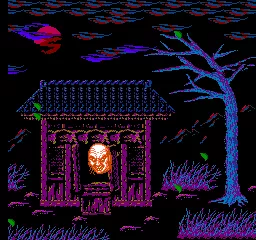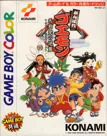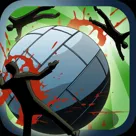Zombie Nation
Description official description
In 1999 a mysterious object crashes into the desert and a mysterious creature, Darc Seed appears. Using magnetic powers, he soon turns the people of the United States into zombies and exerts influence over various weapons and objects. Among the weapons Darc Seed claims is the legendary samurai sword, Shura. When the great head of the samurai, Namakubi hears about this, he sets out for the United States to defeat Darc Seed and reclaim the sword.
Zombie Nation is a side-scrolling shooter in which the player can control Namakubi's movement across the screen and the ability to shoot. The hero's designation as a "great head of the samurai" is to be taken literally: Namakubi is indeed a giant disembodied head. His main weapon is the ability to shoot projectiles from his eyes and bombs from his mouth which he fires at various enemies, objects and buildings. Furthermore, should a zombie hostage fall out a window he can rescue them to slowly power up his attacks. Enemies reduce health by varying amounts; health can be restored by increasing the player's score. The game features four distinct stages with two difficulty settings.
Spellings
- 暴れん坊天狗 - Japanese spelling
Groups +
Screenshots
Promos
Credits (NES version)
14 People (10 developers, 4 thanks)
| Executive Producer | |
| Executive Produced by (Japanese version) | |
| Produced by | |
| Directed by | |
| Game designed by | |
| Graphics designed by | |
| Sound created by | |
| Special Thanks to | |
| Program designed by | |
| Presented by |
|
Reviews
Critics
Average score: 70% (based on 9 ratings)
Players
Average score: 2.5 out of 5 (based on 19 ratings with 1 reviews)
No one lives long, not even you.
The Good
The gameplay isn't very deep, but it's what you'd expect from a game as insane as this. You simply blow up buildings, shoot down every enemy you see and eat people to power up. You also have a health bar, unlike a lot of other shooters of the time. It's not made very clear in-game how you gain health, but if you're good enough, it won't be too much of a problem.
The visuals in this game are surprisingly fluid, given the limited scope of the NES. As you destroy buildings, the parts you blow up catch on fire, and the fire is has some surprisingly fluid animation, in fact there are a lot of background objects in the game that have this level of animation, from storm clouds, to waterfalls and even the lasers that come from the background. There are even some things that happen far away in the background of level 1, as lasers are pointed at the sky by people awaiting, and fearing, your arrival. In addition, the characters and bosses seem to have a large amount of detail as well. Granted, this quality isn't applied to a lot of small objects, such as planes, helicopters and people, but it's a very visually-impressive game. Without a doubt, the level that looks the best is level 2-1, with nearly the entire top half of the screen filled with finely animated storm clouds and lightning. The only thing I can complain about is the just-as-abundant level of sprite flicker and slowdown. However the former happens much more often than the latter.
Finally, I really like the soundtrack to this game. Most people I know aren't a fan of music by Norio Nakagata, but I like his sort of avant-garde style when it comes to composition. Here, it applies very well, giving off sort of a gothic vibe in some songs, while expressing depression in others, and all the while, the melodies and bass lines scream with energy. I especially love the level 1-2 theme, the level 4-1 theme, and the credits theme.
The Bad
The original Japanese title translates out to Rowdy Tengu, which makes sense since you are destroying a large portion of the United States. However, the US story says the character comes to the United States to save everyone. Yet, there is no one that you actually save. You just kill everyone! Also, despite everyone in the US being turned into zombies, they can still pilot vehicles, construct machinery, and fire guns. The Japanese version seems to have a more comprehensible story, but I personally haven't taken the time to translate it, so I don't know what the final boss has to do with anything. However, in an old NES game like this, there are MANY more things that can be wrong with it.
One thing that bugs me, and might bug others quite a bit, is the fake difficulty. On the round select screen, pressing select switches between Easy and Hard difficulties. The difference isn't necessarily increased damage to you, but the controls are driftier, making the avoidance of a lot of enemies even harder. That is hardly fair with all the rocks that fall from the top of the stage, the massive amounts of bullets onscreen (most of which flicker or disappear), and the tricky enemy patterns.
However, the one thing that is the most irritating about this game is that during a boss battle, your health bar disappears. I assume this is to make room for the bosses, which are made of background tiles. If they were made of sprites they'd probably slow the fights to a crawl. It really is a pain because you don't know how close you are to dying, and a lot of boss attacks can drain almost your entire health bar, or even kill you in one hit! Oh, and speaking of these attacks, several stages have some kind of beam that reduces your life bar to one unit. And the higher the number of the stage, the more frequently these beams activate. In addition to this, if you don't react quickly enough, these beams can trap you on the left side of the screen, waiting to be zapped. When it comes to keeping yourself safe, the game, on many occasions, decides that that isn't an option.
The Bottom Line
It's not as bad as a lot of people make it out to be. True it can be unfair at times, but it's still quite enjoyable because of the variety in enemies, stages, bosses and mechanics. And on top of all of this, it might be one of the first video games where you play as a villain. It's also not quite as hard as a lot of other shooters despite the weird enemy patterns and whatnot. I'd recommend it, but there's a lot of things in this game that are GUARANTEED to bug some people.
NES · by spoonybard13 (8) · 2014
Trivia
Japanese version
The original Japanese version had the hero as a Tengu mask instead of a severed head.
Rumor
One of the popular rumors regarding this game is that it resulted from a translation error between Japanese and Americans regarding the term "great head of the samurai" (used to denote the leader of samurai), one side of the development team having taken the term literally.
Unfortunately, while it makes a good story, the rumor is false as this game was released originally involving a character who was konoha tengu, otherwise known as a severed head spirit. So the nature of this game was fully intended.
Information also contributed by WildKard
Analytics
Upgrade to MobyPro to view research rankings and price history! (when applicable)
Identifiers +
Contribute
Are you familiar with this game? Help document and preserve this entry in video game history! If your contribution is approved, you will earn points and be credited as a contributor.
Contributors to this Entry
Game added by Shoddyan.
Additional contributors: chirinea, Alaka, Marguerite Richardson.
Game added February 5, 2004. Last modified June 11, 2024.
















